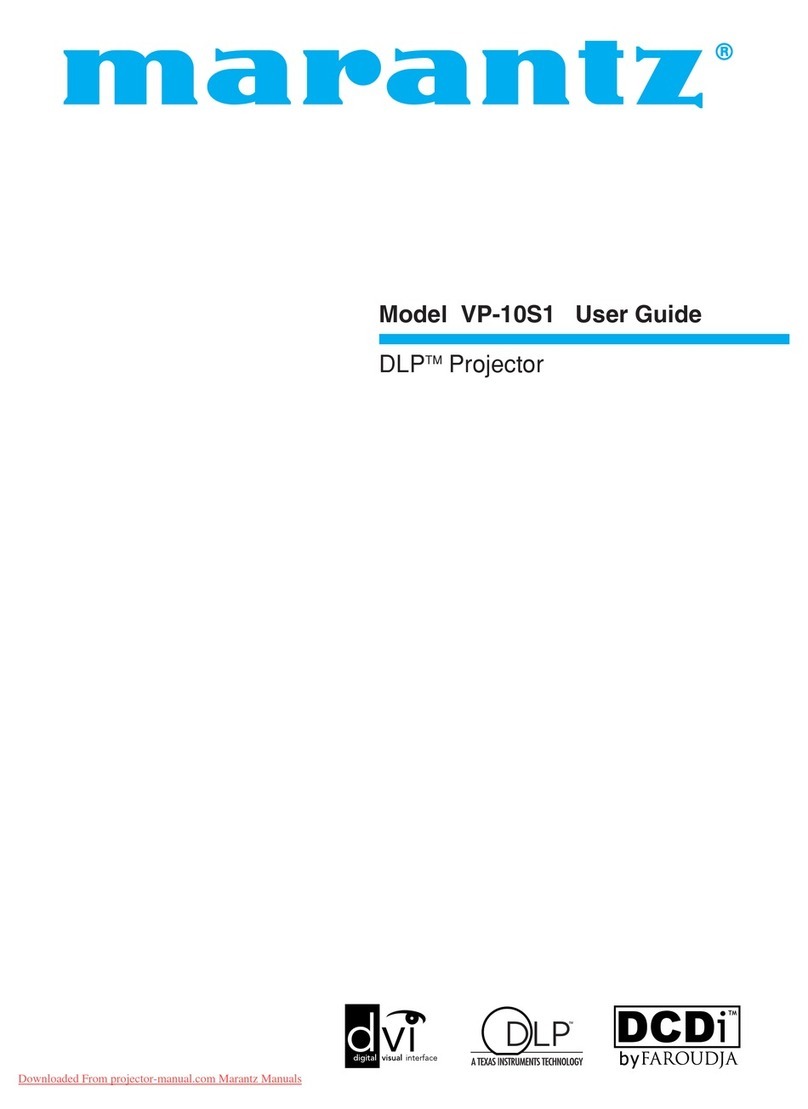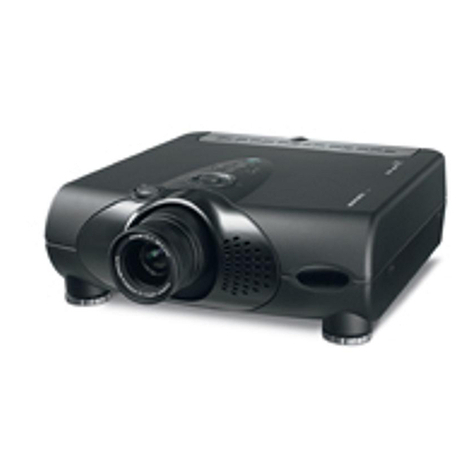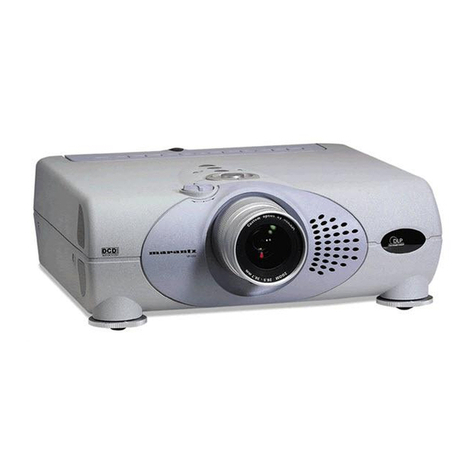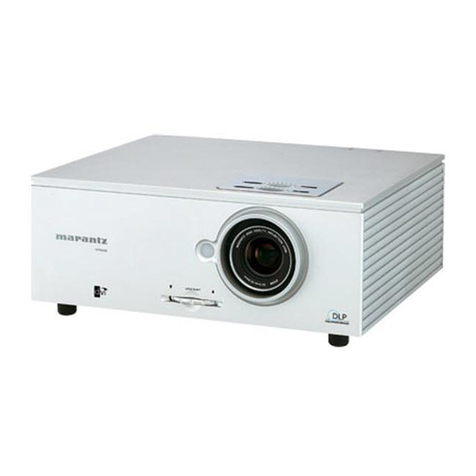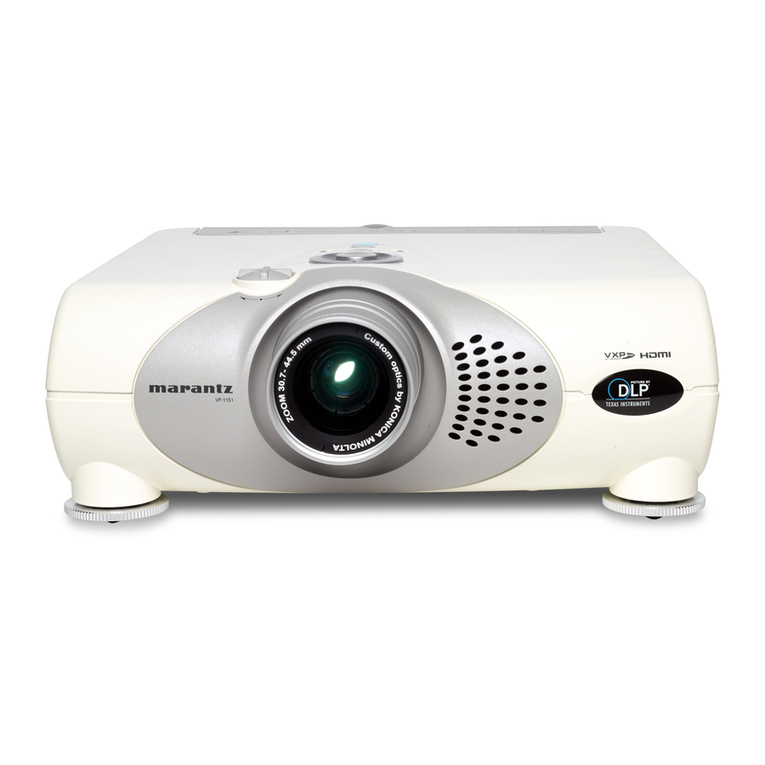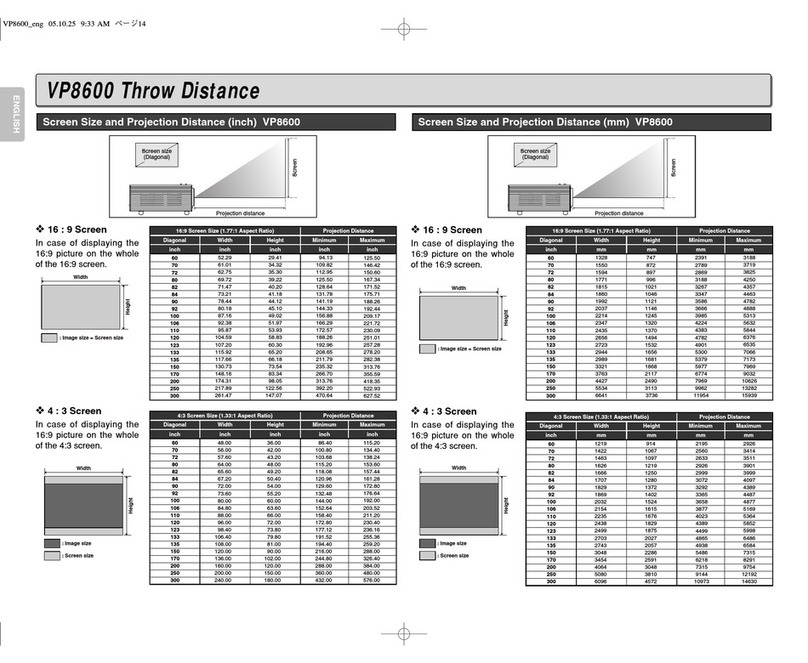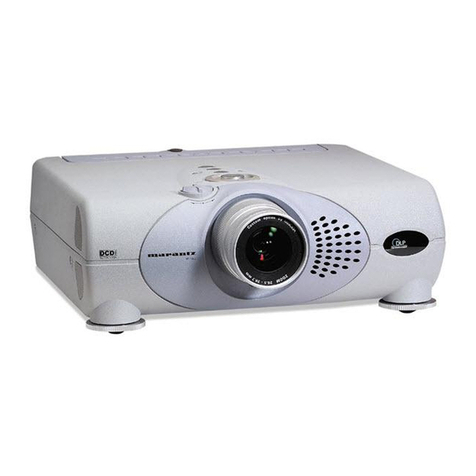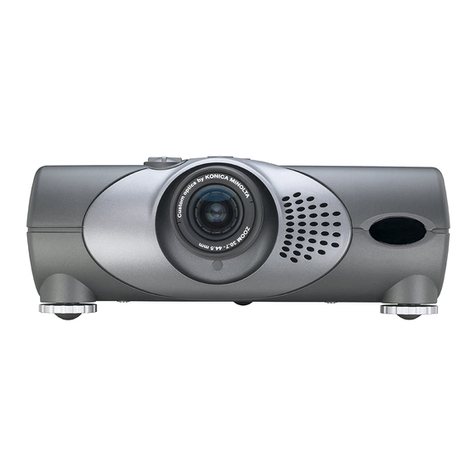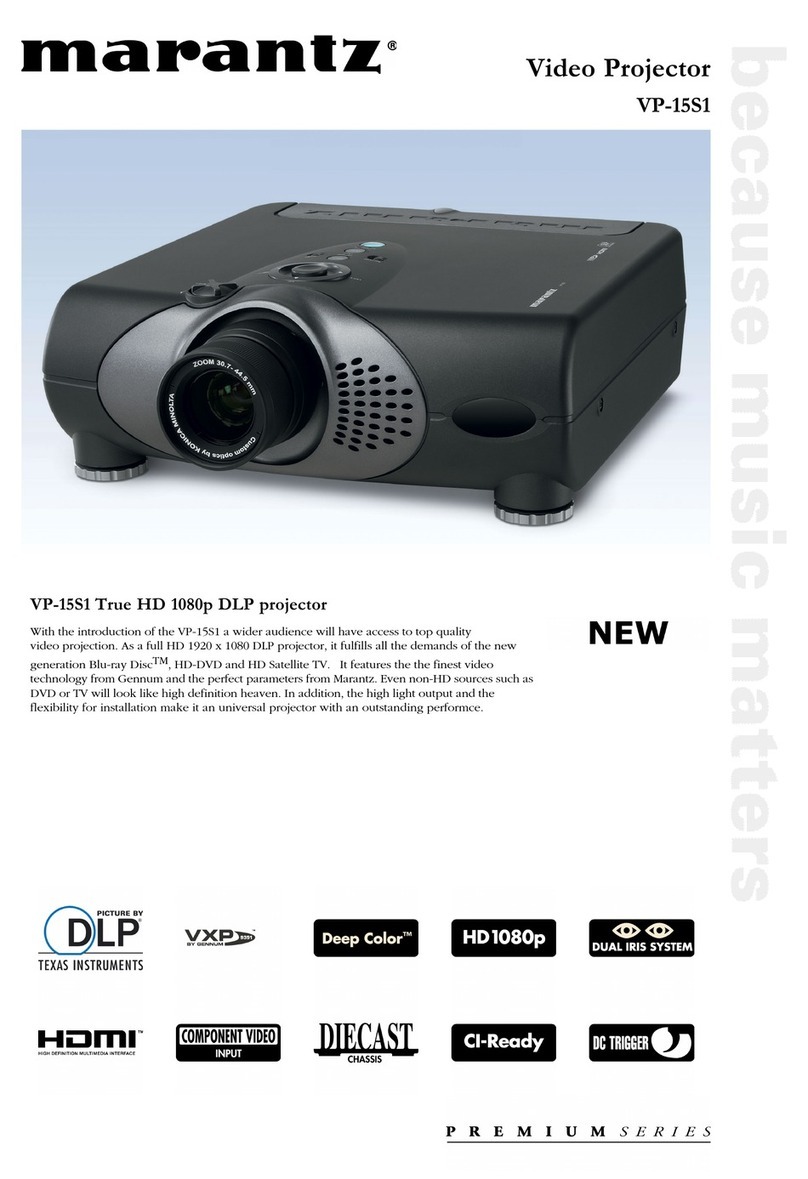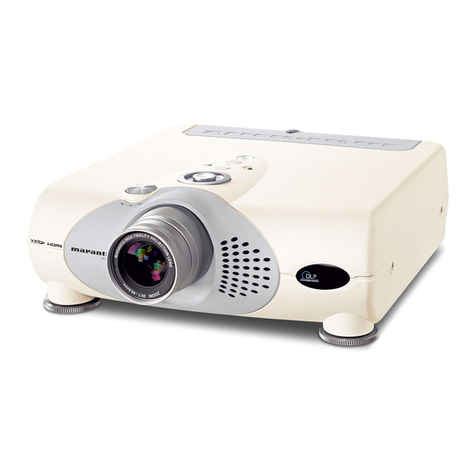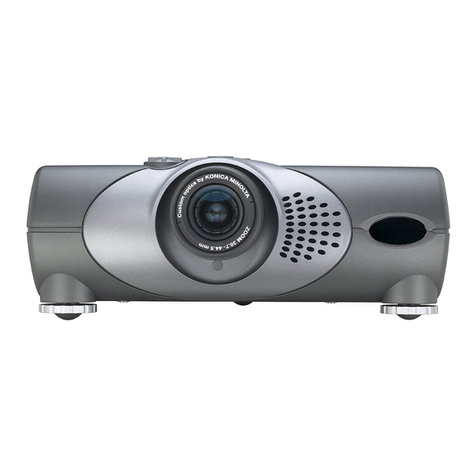
Appearance
The projector has a light gray case with
a sparkly metal-flake finish. A somewhat
darker bezel surrounds the larger than nor-
mal lens assembly, which is slightly offset
from the center of the projector. The fans
exhaust warm air through the front bezel. A
manual lens shift dial is located on top of the
case, along with a set of operating controls.
All inputs are on the recessed rear panel.
Setup
A 16:9 (1.78:1) screen should be used
to match the projector’s native aspect ratio.
With a 100-inch diagonal (87 3/16-inch x
49-inch) screen, the short throw Minolta
zoom lens provides a lens-to-screen throw
distance of between 10 feet 9 inches and
12 feet 6 inches. The long throw zoom lens
provides a throw distance of between 16
feet 8 inches and 22 feet 7 inches. Focus
and zoom are manual adjustments—not
available from the remote control.
The mechanical lens shift function per-
mits the center of the lens to be mounted
anywhere between the top and bottom
edge of the screen, regardless of whether
the projector is ceiling mounted or table
mounted. The projector can be tilted if it
must be located above or below the screen,
but this will cause the picture to keystone.
Electronic Keystone Correction can be used
to restore the image to a rectangle, but key-
stone correction produces moiré patterns
on closely spaced lines, so it should be
avoided if possible.
Connections
The rear panel has six video inputs—
one composite (RCA connector), one S-
video (4-pin mini-DIN), two YPbPr (RCA
connectors), one RGB (15-pin D-sub), and
a DVI-D input. The YPbPr component video
inputs accept standard-definition or high-
definition signals. The RGB input accepts
signals with positive or negative HV sync,
but not sync on green.
The DVI-D input, which includes HDCP
(High-Definition Content Protection), can be
configured in a menu to accept digital RGB
or YCbCr signals. The latter can be set for
standard or high-definition color decoding.
You can select the Normal mode for DVI
signals with RGB-Video levels (black at digital
code 16 and 100 IRE at 235), or the Extend
mode for RGB-PC levels (black at 0 and
100 IRE at 255). The black level is switched
correctly, but you will want to re-adjust the
contrast levels if you switch signal types.
The YPbPr inputs are compatible with
480i/p, 540p, 576i/p, 720p, 1035i, and 1080i
video formats. In addition to the usual 50,
59.94, and 60 Hz field and frame rates, the
projector also displays 48 Hz 720p and
1080i signals at their native vertical rates. (I
wasn’t able to try that feature.) The analog
RGB input is compatible with the same
video formats, and 60 Hz PC display for-
mats up to 1024 x 768. According to the
manual, PC formats at other vertical rates
will be accepted, but not displayed proper-
ly. The DVI digital input accepts the same
video formats and 60 Hz PC formats.
The rear panel includes an RS-232C
control port, and Remote Control In and Out
jacks for connection to a Marantz audio
component. There are also two 12V Trigger
output terminals. One is active whenever
the projector is turned on, and the user can
specify which aspect ratios enable the other
12V output to control screen masks.
The rear panel also includes a standard
three-prong power cable socket and a light
switch that illuminates the rear panel for
changing cables in a dark room. That much
appreciated feature even works when the
projector is in standby mode.
Controls
The slender 1.75-inch-wide remote con-
trol is logically laid out, but only seven of
the 25 buttons are backlit. Those include
the Menu, V-Mute (picture mute), Input,
Aspect, Pattern, Standby, and Power On
buttons. There are also six dedicated input
buttons, four Aspect Ratio buttons, and four
buttons that select Picture Modes. On-
screen menu items are navigated and
selected with a tilting cursor-pad button.
There are also buttons for changing the
deinterlacing mode and displaying status
information.
The Standby button is an annoying oper-
ator trap that immediately turns off the pro-
jection lamp without asking for conforma-
tion. If it is pressed accidentally you must
wait for the entire cooling off period before
the projector can be turned back on again.
The top of the projector includes an alter-
nate set of buttons for on-screen menu naviga-
tion, input selection, the focus pattern, and Power
On/Standby. There are also Warning/Lamp,
Power, and Standby indicators. The maxi-
mum lamp life is 2,000 hours, but Marantz
recommends replacing the lamp after 1,000
hours. The lamp is user replaceable.
On-Screen Menus
The on-screen menus are arranged in
hierarchical levels. The Main menu includes
Picture Adjust, Setting, System, Display,
Config, Trigger 2, and Preset.
The Picture Adjust submenu provides
Contrast, Brightness, Color (Saturation), Tint
(Hue), Sharpness, Noise Reduction, Color
Temperature, and Fine Menu. When a vari-
able Picture Adjust item is selected, the
menu disappears and is replaced by a sin-
gle bar graph and numerical value near the
bottom center of the screen, which makes it
easier to perform adjustments without part
of the picture being covered. When the
adjustment is completed the menu reap-
pears. The Picture Adjust items change
depending on the input and the signal for-
mat. For example, the Tint and Noise
Reduction controls are only available for
composite and S-video signals.
The Fine Menu item produces a submenu
that includes Luminance, Chrominance,
Sub Control, and Miscellaneous. The first
two items provide a large number of adjust-
ments for detail and edge enhancement. I’ll
discuss those in a separate section. The
Sub Control item produces a menu that
includes red, green, and blue (RGB) Contrast
and Bright controls, which are equivalent to
the usual RGB Gain and Bias controls for
adjusting color temperature and grayscale
tracking. There are also Clamp Width and
Clamp Position adjustments for analog RGB
signals, which can be useful for signals that
have non-standard timing. The Miscellaneous
item produces a menu that includes DCDi™
(On/Off), CCS (cross color suppression)
(On/Off), FRC (frame rate conversion)
(Auto/On), and Sharpness Filter (0-4).
The Setting submenu includes Lamp
mode (High/Low), High Bright (On/Off),
Aspect Ratio, VCR mode (On/Off), Cinema
(Auto/Off), Iris (5.0/3.0), and Black Setup.
The Lamp mode changes the lamp bright-
ness by switching the lamp power. The
High Bright mode increases brightness by
producing an overly blue gray scale and
should be avoided for critical viewing. The
VCR mode is for poor quality video sources.
It forces the projector to use intra-field verti-
cal interpolation for deinterlacing and
should be left off for DVDs and most broad-
cast video. The Cinema mode enables
inverse-telecine deinterlacing for standard-
definition film sources. The F5.0 Iris mode
maximizes the contrast ratio at the expense
of picture brightness. Black level setup
selects a 0 IRE or 7.5 IRE black level for
analog input signals, and RGB-video or
RGB-PC levels for DVI signals.
The System submenu selects the signal
format (Auto, NTSC, PAL, 480i, 720p, etc.)
for each input, but the Auto value worked
fine for all of my sources. This menu also
provides RGB or YCbCr (standard or high
definition) selection for the DVI input.
The Display submenu includes Vertical and
Horizontal Keystone, Auto Adjust, Vertical
and Horizontal Size and Position, and Phase.
Equipment
Review
Widescreen Review • Issue 84 • May 2004
38 Page 2/7
#84 Master Pages 26-49 3/22/04 4:30 PM Page 38
